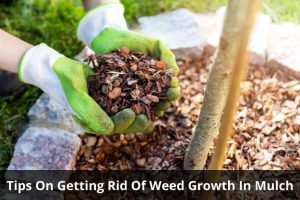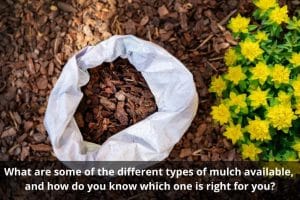Mulching is a great way to keep your plants healthy and looking good, but if you don’t take care when putting them down, you could end up with a weed problem. In this blog post, we will give you some mulching tips for getting rid of weed growth. Keep reading for more information.
Growing marijuana indoors requires great care as well as some maintenance techniques. One of the major concerns is how to get rid of weeds around the entire area while still keeping the mulch intact.
You need to make sure that the mulch doesn’t end up becoming a weed seed magnet. If you have a good mulching technique, weed seeds won’t grow in your garden. As a matter of fact, mulching will prevent weeds from sprouting in the first place. Also, if you use good quality mulch, then you don’t have to worry about losing any valuable nutrients to the ground.
What is weed growth in mulch and why does it happen?
Weed growth in mulch can happen for a number of reasons. It could be that the mulch you’re using isn’t thick enough, or that it’s not covering the entire weed (leaving gaps for sunlight to reach the weed and allow it to grow). Additionally, if the mulch is too thin, it could be allowing light and warmth to reach the weed seeds, which will promote germination. If your Mulching tips aren’t suppressing weeds, it might be time to try a new method.
How can you tell if your mulch has weed growth, and what are the symptoms of it spreading to other plants in your garden or yard?
If you notice that weeds are beginning to sprout up in your Mulch, it’s important to take action right away. If left unchecked, weed growth can quickly spread and take over flower beds, gardens, and landscapes. Symptoms of weed growth include:
- New weeds sprouting up in Mulch
- Weeds growing in cracks and crevices
- Weeds taking over flower beds and garden areas
- Mulch that is thinning out or doesn’t cover the entire area
If you notice any of these symptoms, it’s important to take steps to get rid of the weeds before they have a chance to spread further. Additionally, if you’re Mulching a new area, be sure to apply a pre-emergent herbicide to prevent weeds from germinating in the first place.
What are some Mulching tips to prevent weed growth?
- Use a thick layer of mulch: A layer that is 2-3 inches thick should be sufficient to block out sunlight and prevent weed seeds from germinating.
- Make sure the mulch covers the entire area: Be sure to Mulch all the way to the edges of flower beds and walkways. This will help prevent weeds from growing in cracks and crevices.
- Choose an organic mulch: Pine needles, bark chips, and straw are all great options for Mulching. Not only will they help suppress weed growth, but they’ll also add nutrients to the soil as they break down.
What are some of the different types of mulch available, and how do you know which one is right for you?
There are a variety of Mulches available on the market, each with its own benefits. Some of the most popular Mulches include:
Bark chips
Bark chips are a great option for Mulching because they’re long-lasting and help suppress weed growth. They also add nutrients to the soil as they break down over time. One of the keys to using bark chips effectively is to apply them at the right thickness. A layer that is too thin will not be effective at suppressing weeds and may actually promote weed growth. A layer that is too thick can be difficult to remove if you decide you want to change your Mulching Tips later on. When applying bark chips, be sure to remove any existing weeds first. This will give the chips a chance to do their job without having to compete with weed growth.
Straw
Straw is a popular mulching option because it is readily available and relatively inexpensive. You can find straws at most garden stores or online. It is also relatively easy to apply, although it can be messy. Straw is effective at suppressing weed growth and helping to retain moisture in the soil. It is also biodegradable, so it will eventually break down and add nutrients to the soil. When using straw as mulch, be sure to apply it thickly (3-4 inches) and keep it away from the base of your plants. Otherwise, it can harbour pests or diseases.
Pine needles
Pine needles have a few things going for them as mulch. They are relatively inexpensive and easy to find, and they make a great aesthetic addition to your landscape. When it comes to killing existing weeds, pine needles work best as a pre-emergent herbicide. This means that they will prevent weed seeds from germinating in the first place. If you already have a problem with weeds, you can still use pine needles to help control the growth. Simply apply a thick layer of pine needles over the area and allow them to do their work.
Pine needles are also a great organic mulch option. They will break down over time and add nutrients to your soil. This is especially beneficial if you are growing in Mulch beds or flower beds. The best way to determine which Mulch is right for you is to consider your specific needs. Think about the type of plants you’re growing, the climate you live in, and the amount of time you’re willing to spend maintaining the Mulch.
Once you’ve taken all of these factors into consideration, you should be able to narrow down your options and choose the Mulch that’s right for you.
Are there any preventative measures that can be taken to help reduce the likelihood of weed growth in mulch happening in the first place?
Yes, there are a few preventative measures that can be taken to help reduce the likelihood of weed growth in Mulch. Some of the most popular methods include:
Applying a pre-emergent herbicide
Applying a pre-emergent herbicide to your Mulch before weeds have a chance to sprout will help prevent them from taking over. Be sure to follow the directions on the herbicide packaging and apply it according to the manufacturer’s recommendations
Laying down landscape fabric
Landscape fabric is a great way to prevent weed growth because it blocks sunlight and prevents weeds from sprouting. Be sure to lay it down before you add Mulch to your beds and gardens.
Adding Mulch regularly
Adding a fresh layer of Mulch to your beds and gardens on a regular basis will help prevent weeds from taking over. Mulch acts as a barrier, preventing weed seeds from germinating and taking hold.
What are some of the common mistakes people make when trying to get rid of weed growth in mulch?
There are a few common mistakes people make when trying to get rid of weed growth in Mulch. Some of the most common mistakes include:
- Not removing all of the weeds: When pulling weeds, be sure to remove the entire plant, roots and all. If you leave any part of the plant behind, it can regrow and spread.
- Not applying herbicide correctly: If you’re using a herbicide to kill weeds, be sure to follow the directions on the packaging and apply it correctly. Incorrect application can result in herbicide-resistant weeds.
- Not Mulching regularly: Mulch acts as a barrier, preventing weed seeds from germinating. If you don’t Mulch regularly, weed seeds will have a chance to take hold and grow.
What should you do if your entire garden or yard is affected by weed growth in mulch, and how much time and effort will it take to completely eradicate it from your property?”
If your entire garden or yard is affected by weed growth in Mulch, the best course of action is to contact a professional for mulching tips. They will be able to assess the situation and recommend the best course of action. Depending on the extent of the weed growth, it may take some time and effort in applying mulch and completely eradicate it from your property.


